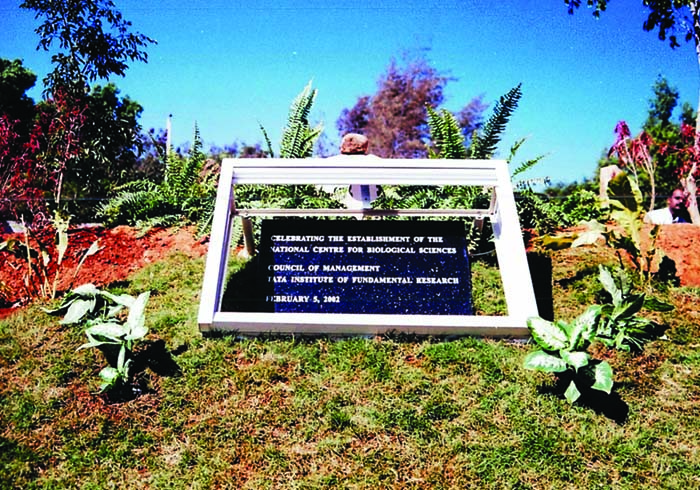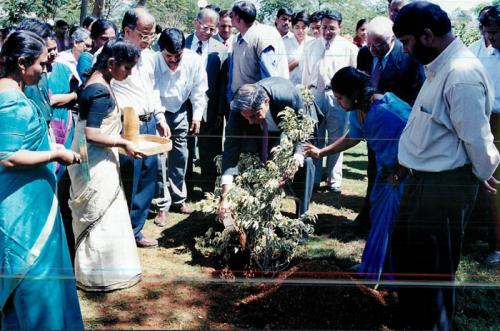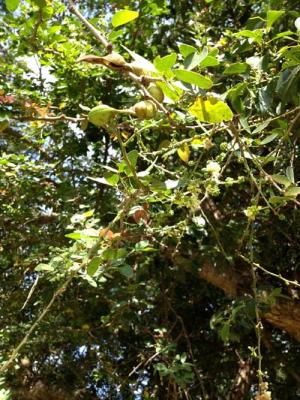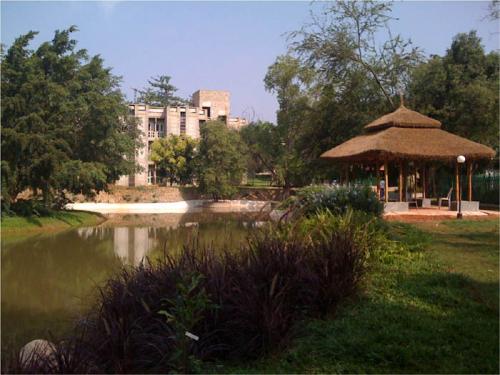The Story of the Pond
The picturesque pond at NCBS was originally a low lying area close to the students' hostel Parijatha. It formed the south western part of the space allotted to NCBS by GKVK. NCBS moved to its present campus from the premises of the Indian Institute of Science (IISc) in 1998-99. By then, the Academic Research building (now named the Eastern Laboratories), the Housing and Hostel buildings, the Sub-Station and Chiller plant as well as the Stores building (which was the first building to be constructed at NCBS and used as its site office) were constructed. Subsequently, the stores moved to its present location in the year 2002-03, making way for housing the computational services.
The Karnataka Government allotted 4.2 acres of land in Chikka Bommasandra, Yelahanka for NCBS (where the Mandara Hostel is now constructed). In the year 2000, an underground sump of 8 lakhs liters capacity was constructed on this land. This plot had a few small dwellings which were demolished. Size stones that were used in the foundations of these demolished dwellings were shifted to NCBS, at GKVK campus in the year 2000-2001.
During 2001-2002, Technical-Head Dr. Jayant B. Udgaonkar communicated to us that NCBS should enjoy a reasonably large-sized pond, by increasing the extent and depth of the low lying area. Accordingly, with the help of an earth digger, the work of excavating and enlarging the pond was taken up. The debris that was already scattered in the low lying area was moved to the central portion and the excavated earth was dumped on the debris and the island finally created. Rain water from all the buildings and the surrounding regions were also channelized to reach the pond. All the thorny trees thriving in this region were removed. However, extreme care was taken to retain one sweet tamarind tree, which flourishes even now on the bund (see picture). The excavated earth was also used to create a bund along the sides of this pond, the entire area was then leveled and dressed. Stone pitching was later taken up to retain the earth and shape of the pond, using all the size stones available at NCBS from the previous constructions and those transported from Yelahanka. In order to retain water in the pond, the lower portion of the bund and pond bed were lined with stone. Suitable low level light fixtures were selected and positioned on the bund adjoining the pond to provide more or less uniform lighting, without hampering the view of the pond from the surroundings. By the end of year 2002, the pond was in shape and ready to store rain water.
In February 2002, the 'Establishment of NCBS campus' was dedicated to the 'Council of Management' of the Tata Institute of Fundamental Research. The dedication stone was designed as a part of the Pond Island. A couple of Ficus trees were planted along with a few cacti and varieties of bougainvillea to highlight the 'Dedication Plaque' and to enhance the beauty of the island. On this occasion, the members of the Council of Management - Sri. Ratan Tata, Dr. S.S. Jha, Dr. Anil Kakodkar, Dr. M.G.K Menon and Dr. C.N.R. Rao - planted trees on the bund. The beauty of the bund was enhanced by planting a few more species of trees and bamboo. The bund became one of the most used spaces, hosting a number of lunches and dinners, also during workshops and seminars organized by NCBS. Setting up a lawn, planting shrubs, trees and ground cover all along the slope along the upper portions of the pond and bund were completed in the year 2002.
Shortly after, the pond began to collect water when it rained. A few species of fish were released into the pond and water lillies planted. However, the extent of percolation and evaporation was so high that water would almost vanish during summers. While the stone material itself was porous, the joints were also not made fully water tight. This allowed water seepage into the water table, giving the pond a dry look. Later Dr. Upinder Singh Bhalla, who chairs the Technical and Research Services Committee, urged us to take suitable measures towards retaining the water in the pond and making the place attractive for birds. Several changes were made, viz., the island was lowered, the vertical stone wall on the base of island was removed and a stepped slope emerged (from April to October 2009). Finally water proof concreting of the pond basin was carried out in early 2010. Plants and shrubs that attract birds were chosen. The concrete surface was then topped by earth for a natural look and to allow biomass. At last, the pond now always has lots of water in it and we see birds around the pond.
The vision of Dr. Udgaonkar and Dr. Bhalla has been realized.






Comments
Post new comment